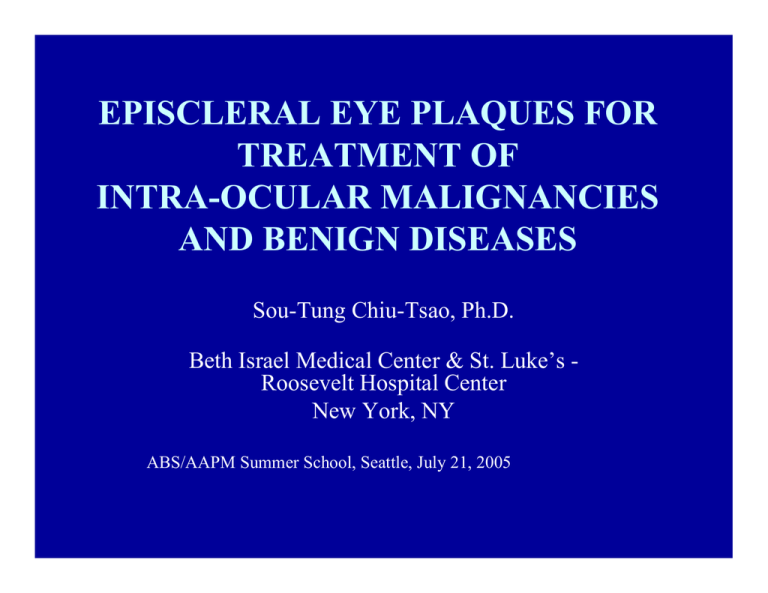EPISCLERAL EYE PLAQUES FOR TREATMENT OF INTRA-OCULAR MALIGNANCIES AND BENIGN DISEASES
advertisement

EPISCLERAL EYE PLAQUES FOR TREATMENT OF INTRA-OCULAR MALIGNANCIES AND BENIGN DISEASES Sou-Tung Chiu-Tsao, Ph.D. Beth Israel Medical Center & St. Luke’s Roosevelt Hospital Center New York, NY ABS/AAPM Summer School, Seattle, July 21, 2005 Goal • To present the Procedures involved in the Eye Plaque Treatments of – Intraocular Malignant Tumors – Benign Diseases Introduction • Normal Eye Anatomy • Intra-ocular Malignancies in Eye • Episcleral Eye Plaques Eye Anatomy • Outer Layer – Sclera – Cornea equator ciliary body sclera ora choroid limbus • Middle Layer - Uvea – Choroid – Ciliary Body – Iris retina iris lens – Retina optic axis optic disc cornea optic nerve limbus • Inner Layer foveola ora Intra-ocular Malignant Tumors • Uveal Melanoma – Choroidal Melanoma – Ciliary Body Melanoma • Retinoblastoma • Retinal Detachment Choroidal Melanoma equator limbus or a lens f ov eola . apex optic nerv e choroidal m elanom a base eye plaque Choroidal Melanoma • Tumor Base: all pigmented areas of tumor adjacent to the underlying sclera • Sclera Thickness: 1 mm • Interior Sclera: center of tumor base at 1mm from the exterior surface of sclera • Apical Height: distance between interior sclera and tumor apex Macular Degeneration • Benign ophthalmic condition characterized by – progressive destruction and – dysfunction of the macula (central retina ) • Age-related macular degeneration is the leading cause of blindness in the United States. Episcleral Eye Plaque Radionuclides – – – – – I-125 Pd-103 Ru-106 Co-60 Sr-90 Physical forms – Multiple loose seeds assembled in a gold substrate – Prefabricated plaques 60Co • • • • Eye Plaques 1930’s Early Designs, CKA series Prefabricated Plaques Within the tumor, dose distributions are very similar to I-125 Plaques of comparable diameters • Delivers higher doses to critical normal structures • Loosing popularity due to higher energy • Issue of personnel protection 106Ru Eye Plaques • Prefabricated Plaques • 16 Different Sizes • Dose distributions have been calculated and measured • Popular in Europe • Available from Bebig, Germany 90Sr Eye Applicator • Used more frequently for treating Pterygium (Next lecture) • Used for treatment of shallow tumors • Prefabricated applicators 125I Eye Plaques • Started in the early 1970’s • Gold foils made by dental labs serve as substrates • 125I seeds (model 6711) were glued onto the concave side of a selected substrate • Gaining acceptance • COMS group formed based on the early experience with 125I Eye Plaques 103Pd Eye Plaques • After 103Pd seeds became available • 1990’s • 103Pd seeds (model 200, Theraseed) were glued onto the concave side of a selected substrate • The substrate can be of – COMS design (gold backing alone, no silastic) – Non-COMS design • Prefabricated plaques under investigation Roles of Professionals • After an ophthalmologist makes the diagnosis of intra-ocular melanoma or benign disease, he/she refers the patient to radiation oncologist for consultation. • When eye plaque treatment is chosen as the treatment modality, the physicist participates in and organizes – treatment planning tasks – quality assurance of treatment delivery – radiation safety procedures Collaborative Ocular Melanoma Study (COMS) • COMS was started by National Eye Institute in the mid 1980’s • Patients with medium size tumors between 2.5 and 10 mm in apical height, and 16 mm or less in basal diameter, were randomized between – Enucleation (Eye removal) – I-125 eye plaque treatment Medium Size Tumors • Apical height: 2.5 to 10 mm • Basal diameter: 16 mm or less • Randomization Arms – Enucleation – I-125 eye plaque treatment COMS findings (2001) • The survival rates are comparable for patients with medium size tumors treated with – Enucleation (Eye removal) – I-125 eye plaque treatment • Eye Plaque Treatment is Effective. Pre-treatment Tumor Localization • Ophthalmoscopy – Fundus Photography • • • • Ultrasound A-scan and B-scan Images CT Scan Images (optional?) MRI Scan Images (optional?) Correlation of Localization Modalities Ophthalmoscopy • Direct • Indirect Wide Angle Narrow Angle • Optic Disc Diameter (DD) about 1.5 mm • Distance between two interest points on eye retina – estimated in multiples of DD Fundus Diagram Drawing • Tumor Dimensions and Location • Tumor Base – Longitudinal Dimension in a Meridian – Transverse Dimension across the Meridians • Critical Normal Structures – – – – Optic Nerve Optic Disc Macula Foveola Fundus Diagram Drawing 12 R 11 1 temporal nasal 2 10 5mm 7mm 9 3 9mm 10mm 8 4 7 6 5 Cross-sectional Diagram temporal 14mm plaque optic disc limbus nasal ora equator optic nerve Guidelines of Radiological Physics Center (RPC) • Selection of plaque size – longest tumor base diameter in mm plus 4 to 6 mm • COMS standard plaques – 10, 12, 14, 16, 18, 20 and 22 mm in diameter – gold plaque with silastic seed carrier insert • Dummy plaques – 12, 14, 16, 18 and 20 mm in diameter – silver rim, acrylic in center • Seed activity: 0.5 to 5 mCi COMS Dose Prescription • Prescription dose – 100 “old” Gy (85 “new” Gy based on the TG43) – delivered in 5 to 12 consecutive days • Prescription dose rate – between 0.5 and 1.25 Gy/hr. • Prescription point – 5 mm from tumor base center (interior sclera) for a tumor with height 5 mm or less, – tumor apex point for height over 5 mm Clinical Interest Points for Point Dose Calculation and Reporting • tumor apex • 5 mm depth from interior sclera (if different from apex) • tumor base center (interior sclera) • center of optic disc • center of lens • opposite retina (22 mm from interior sclera) • foveola (center of macula) Critical Normal Structures • • • • • • sclera macula optic nerve optic disc retina lens COMS Standard Eye Plaques Diameter (mm) 10 12 14 16 18 20 22 # Seed Slots 5 8 13 13 21 24 21 COMS Standard Eye Plaques Gold Plaque Silastic Insert Gold Silver Copper Palladium Carbon 25% Hydrogen 6% Oxygen 29% Silicon 40% Platinum 0.005% 77% 14% 8% 1% COMS Standard Eye Plaques COMS Standard Eye Plaques 14 mm COMS Eye Plaque Y ( a) ( b) 0 .5 mm 6 1 4 mm 5 5 2 .7 5 mm 9 10 1 8 4 su t u r e lu g X 2 4 1 mm 3 11 3 6 7 12 2 1 13 1 2 .3 mm 2 . 7 mm Seed Trough Diagrams 1 2 mm Plaq ue 1 8 mm PlYaqu e 6 Y 16 6 5 9 17 5 5 10 6 1 1 X 15 4 X 4 2 5 18 4 4 3 3 8 2 11 14 7 13 6 7 3 8 2 3 12 19 21 1 20 2 1 1 6 mm Plaque 2 0 m m P l aque Y Y 6 18 6 19 9 8 4 10 5 5 13 1 20 3 7 X 2 4 11 1 X 4 14 10 8 7 15 13 16 3 21 9 3 12 22 2 23 1 11 4 2 6 6 3 17 12 5 5 2 1 24 Smallest and Largest Eye Plaques 10 mm Courtesy Dr. Mark Rivard 22 mm The COMS design plaques • Circular • Notched • Available from Trachsel Dental Studio, Inc., Minnesota • Designed to accommodate loose seeds • Only models 6711 and 6702 I-125 seed were used for COMS protocol cases • Usable for all new models of I-125 and Pd-103 seeds Notched Eye Plaques Courtesy Dr. Mark Rivard Non-COMS Plaques • Customized Plaques for loose seeds – – – – Elongated With indented seed slots With notch Stamped gold foil • COMS Gold Backing with Dense Packing of Seeds fixed with jet acrylic or silicone glue (without using Silastic Insert) • Prefabricated Plaques under development Ru-106 Eye Plaques Courtesy Bebig. Germany Fundus Photo of an Eye with Choroidal Melanoma Ultrasound A Scan transducer transducer sound beam sound beam Ultrasound A Scan Courtesy Hilaris et al Ultrasound B Scan transducer sound beam Ultrasound B Scan Courtesy Hilaris et al CT Scan Images Courtesy Augsburger (1987 ) Sagittal Coronal Pre-Op MRI Scan Images Courtesy Houdek (1989) Post-Implant Comparison of Modalities Basal Diameter Apical Height Retinal Detachment Specificity Extra-ocular Extension 3-d Plaque Imaging Fundoscopy VV X ? ? X X X US A-Scan X VV X X X X ? US B-Scan V V ? ? ? ? V CT Scan VV VV V V VV VV X MRI Scan VV VV V VV VV VV VV Pathology VV VV V VV VV 2-d N/A Fundus Diagram Drawing 11 temporal s l im bu ora 12 1 11 nasal t or eq ua 10 R nasal 2 1 10 L temporal 2 foveola 9 3 9 3 optic disc optic disc 8 4 6 12 t or eq ua foveola 7 s l im bu ora 5 8 4 7 6 5 Fundus Diagram Drawing L 12 11 1 13.0 (14.0) 10 16.0 (17.9) 2 9.2 (9.5) 17.8 (20.8) 3.4 11.7(12.4) 9 21.1(28.3) 19.3(23.6) 15.6(17.3) 6.3 1.5 16.5(18.7) 19.2(23.3) 21.3 (28.8) 19.1 (23.0) 8 15.6 (17.3) 3 4.6 10.5(11.0) 11.0 (11.5) 5. 7 4 22.0(34.6) 18.4(21.9) 12.0(12.7) 4. 8 2. 4 7 5 6 Fundus Diagram Drawing 12 R 11 1 temporal nasal 2 10 5mm 7mm 9 3 9mm 10mm 8 4 7 6 5 Fundus Diagram Drawings 11 (a) 12 1 temporal R (b) nasal 10 12 10mm 11 nasal 2 14mm 5mm 7mm 9 3 9mm 10mm 8 4 7 6 5 L temporal 12mm 10 2 1 13mm 9 3 8 4 7 6 5 Cross-sectional Diagrams (a) temporal (b) 14mm plaque superior 16mm plaque optic disc optic disc optic nerv e limbus nasal limbus ora equator inferior ora equator optic nerv e 3D Perspective, Plaque over Posterior Tumor 3D Perspective, Plaque over Anterior Tumor Dosimetry for Eye Plaques • Major challenge – Steep dose gradient, high spatial resolution – Tumor dimension and location – Plaque placement relative to tumor location • COMS protocol and guidelines • RPC guidelines • Continuing development and improvement COMS/RPC Dosimetry Requirement • 125I seed – Model 6711 – Model 6702 • • • • COMS standard plaque design Point source approximation Ignore heterogeneity correction Doses to interest points Dosimetry for Eye Plaques • Previous “Apparent” Dosimetry for 6711 seed with point source approximation (Ling, 1983) • Revised “Real” dosimetry for 6711 seed (1994) • TG43 recommended parameters for line source approximation in homogeneous water (1995) • In 1995, COMS adopted the revision of the dose rate constant for 6711 seed, based on TG43 recommendation, but still insisted on using point source approximation for protocol cases. I-125 seed, model 6711 1.5 (a) D r ^2 / S 1.0 0.5 0.0 0.0 homogeneous, Ling 1983 homogeneous, Chiu-Tsao 1990 plaque, de la Zerda 1994 0.5 1.0 1.5 r(cm) 2.0 2.5 3.0 Isodose Curves Single model 6711 Seed in 20 mm Plaque Gold Plaque with Silastic insert Homogeneous Heterogeneity Effect • • • • • Influence of Silastic Insert Influence of Gold Backing Influence of eye-air interface Lip Collimation Effect Interseed interference effect • These were all ignored in the COMS protocol cases, for the lack of consensus of such data. Isodose Curves Multiple 6711 Seeds in an Eye Plaque Homogeneous Courtesy Astrahan With lip collimating effect Treatment Planning • Transferring tumor information based on – – – – Fundus Diagram Ultrasound A-Scan and B-Scan Images CT Scan Images (optional?) MRI Images (optional?) • Plaque Selection • Seed Model (close to 20 new models up to year 2005) • Seed Activities and Availability – Uniform Loading – Differential Loading • Dose Calculations Treatment Planning Computer System • General purpose – Adequate for the COMS dose calculation protocol – NO heterogeneity correction • Special purpose “Plaque simulator” (PS) available from Bebig, Germany Treatment Planning Computer System • “Plaque simulator” (PS) by Astrahan at USC • User can turn on the effect of silastic insert, gold backing and eye-air interface • Accuracy of PS calculations has been evaluated by Knutsen (2001) and Krintz (2002) • Newer enhanced version, Astrahan, IJROBP 2005; 61:1227 COMS 12mm Eye Plaque COMS Protocol Original PS Dose rate in cGy/h with 1 mCi per seed Courtesy Astrahan 2005 Enhanced PS COMS 20mm Eye Plaque COMS Protocol Original PS Dose rate in cGy/h with 1 mCi per seed Courtesy Astrahan 2005 Enhanced PS COMS 20mm Eye Plaque Courtesy Astrahan 2005 from interior sclera Depth Dose Curves along the Central Axis Courtesy IAEA Newer models of Seeds? • The heterogeneity effects are different for Pd103 seeds. • Are the heterogeneity effects determined for model 6711 seed applicable for newer models of I-125 seeds and new design of eye plaques? • More work needs to be done about these effects. – Determination – Implementation in Treatment Planning System Eye Plaque Preparation Eye Plaques in Lead Container Sterilization Bag for Gas Sterilization Operating Room • Transillumination – Marking of Tumor Base Border • Measure with Caliper – Distance from Limbus to Tumor's Anterior Margin – Tumor Base Diameter • Dummy Plaque Suturing • Active Plaque Suturing • Transillumination with Sutured Plaque Transillumination light source Scleral Marking Dummy Plaque Active Plaque Operating Room • Intraoperative Ultrasound Scan with Sutured Plaque • Measure with Caliper – Distance from Limbus to Plaque's Anterior Margin – Cornea Diameter Ultrasound Verification of Plaque Placement Well centered Plaque Courtesy Pavlin (1989) Malpositioned Plaque A posterior tumor plaque edge very close to optic nerve Operating Room • Accidentally Contaminated Plaque • Autoclaving • Gold plaque and silastic insert would survive occasional autoclaving • Acrylic insert in silver dummy plaque would melt in high heat • Push out the acrylic insert before autoclaving silver dummy plaque Post Implant Sagittal MRI Images Courtesy Houdek Removal of Silastic Insert from the Gold Backing Final Dose Calculations • 2-d cross-sectional diagram • Identify – Tumor location – Plaque location (after sutured in place) • Dose calculations • Isodose curve plot • Critical structure dose estimates • Reporting and documentaion CONCLUSION • Procedures involved in the eye plaque treatments of intraocular tumors have been presented. Eye Plaque Treatment is Effective. More work needs to be done to refine the modality!!!


